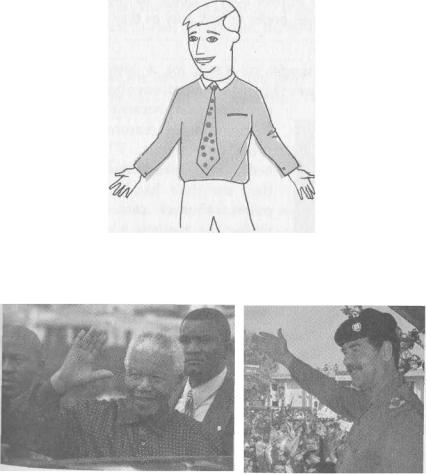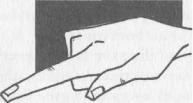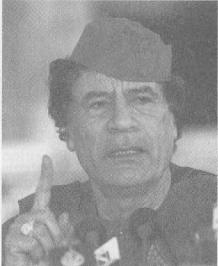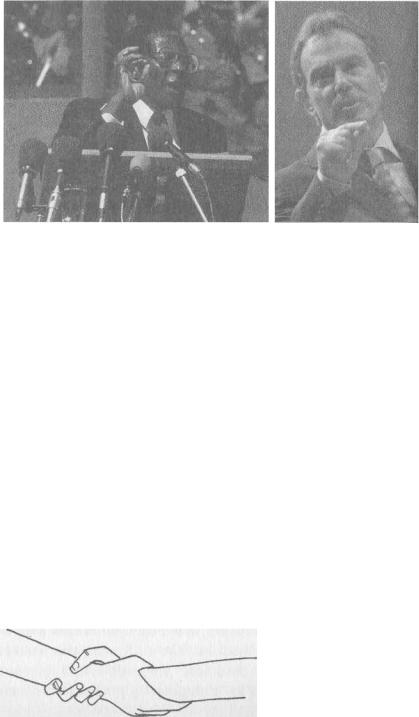
Books on Happiness / The Definitive Book Of Body Language- 2 students
.pdf
The Power Is in Your Hands
How to Detect Openness
When people want to be open or honest, they will often hold one or both palms out to the other person and say something like, 'I didn't do it!', 'I'm sorry if I upset you' or 'I'm telling you the truth'. When someone begins to open up or be truthful, they will likely expose all or part of their palms to the other person. Like most body language signals, this is a completely unconscious gesture, one that gives you an 'intuitive' feeling or hunch that the other person is telling the truth.
'Trust me - I'm a doctor'
The palms are intentionally used everywhere to infer an open, honest approach
33

The Definitive Book of Body Language
When children are lying or concealing something, they'll often hide their palms behind the back. Similarly, a man who wants to conceal his whereabouts after a night out with the boys might hide his palms in his pockets, or in an arms-crossed position, when he tries to explain to his partner where he was. However, the hidden palms may give her an intuitive feeling that he is not telling the truth. A woman who is trying to hide something will try to avoid the subject or talk about a range of unrelated topics while doing various other activities at the same time.
When men lie their body language can be obvious. Women prefer to look busy as they lie.
Salespeople are taught to watch for a customer's exposed palms when he gives reasons or objections about why he can't buy a product, because when someone is giving valid reasons, they usually show their palms. When people are being open in explaining their reasons they use their hands and flash their palms whereas someone who isn't telling the truth is likely to give the same verbal responses but conceal their
hands.
Keeping their hands in their pockets is a favourite ploy of men who don't want to participate in a conversation. The palms were originally like the vocal cords of body language because they did more 'talking' than any other body part and putting them away was like keeping one's mouth shut.
Palms-in-Pockets: Prince William showing the media that he doesn't want to talk
34
The Power Is in Your Hands
Intentional Use of the Palms to Deceive
Some people ask, 'If I tell a lie and keep my palms visible, will people be more likely to believe me?' The answer is yes - and no. If you tell an outright lie with your palms exposed, you might still appear insincere to your listeners because many of the other gestures that should also be visible when displaying honesty are absent and the negative gestures used during lying will appear and will be incongruent with the open palms. Con artists and professional liars are people who have developed the special art of making their non-verbal signals complement their verbal lies. The more effectively the professional con artist can use the body language of honesty when telling a lie, the better he is at his job.
Will you still love me when I'm old and grey?' she asked, palms visible.'Not only will I love you,' he replied, 'I'll write to you.'
The Law of Cause and Effect
It's possible, however, to appear more open and credible by practising open palm gestures when communicating with others. Interestingly, as the open palm gestures become habitual, the tendency to tell untruths diminishes. Most people find it difficult to lie with their palms exposed because of the law of cause and effect. If a person is being open they'll expose their palms, but just having their palms exposed makes it difficult for the person to tell a convincing lie. This is because gestures and emotions are directly linked to each other. If you reel defensive, for example, you're likely to cross your arms across your chest. But if you simply cross your arms you'll begin to experience defensive feelings. And if you are talking with your palms exposed it puts even more pressure on the other person to be truthful too. In other words, open palms can help to suppress some of the false information others may tell and encourage them to be more open with you.
35

The Definitive Book of Body Language
Palm Power
One of the least noticed, but most powerful, body signals is given by the human palm when giving someone directions or commands and in handshaking. When used in a certain way, Palm Power invests its user with the power of silent authority.
There are three main palm command gestures: the Palm-Up position, the Palm-Down position and the Palm-Closed- i Finger-Pointed position. The differences of the three positions are shown in this example: let's say that you ask someone to pick up something and carry it to another location. We'll assume that you use the same tone of voice, the same words and facial expressions in each example, and that you change only the position of your palm.
The palm facing up is used as a submissive, non-threatening gesture, reminiscent of the pleading gesture of a street beggar and, from an evolutionary perspective, shows the person holds no weapons. The person being asked to move the item will not feel they are being pressured into it and are unlikely to feel threatened by your request. If you want someone to talk you can use the Palm-Up as a 'handover' gesture to let them know you expect them to talk and that you're ready to listen.
The Palm-Up gesture became modified over the centuries and gestures like the Single-Palm-Raised-in-the-Air, the Palm- Over-tbe-Heart and many other variations developed.
Palm up = non threatening |
Palm down — authority |
When the palm is turned to face downwards, you will project immediate authority. The other person will sense that you've
3 6

The Power Is in Your Hands
given them an order to move the item and may begin to feel antagonistic towards you, depending on your relationship with him or the position you have with him in a work environment.
Turning your palm from facing upwards to facing downwards completely alters how others perceive you.
For example, if the other person was someone of equal status, he might resist a Palm-Down request and would be more likely to comply if you'd used the Palm-Up position. If the person is your subordinate, the Palm-Down gesture is seen as acceptable because you have the authority to use it.
The Nazi salute had the palm facing directly down and was the symbol of power and tyranny during the Third Reich. If Adolf Hitler had used his salute in the Palm-Up position no one would have taken him seriously - they would have laughed.
Adolf Hitler using one of history's most notable Palm-Down signals
37

The Definitive Book of Body Language
When couples walk hand-in-hand the dominant partner, often 1 the man, walks slightly in front with his hand in the above position, palm facing backwards while she has her palm facing forward. This simple little position immediately reveals to an observer who wears the loincloths in that family.
The Palm-Closed-Finger-Pointed is a fist where the pointed finger is used like a symbolic club with which the speaker figuratively beats his listeners into submission. Subconsciously, it evokes negative feelings in others because it precedes a right over-arm blow, a primal move most primates use in a physical attack.
Pointing finger — 'Do it or else!'
The Palm-Closed-Finger-Pointed gesture is one of the most annoying gestures anyone can use while speaking, particularly when it beats time to the speaker's words. In some countries such as Malaysia and the Philippines, finger pointing at a person is an insult as this gesture is only used to point at animals. Malaysians will use their thumb to point to people or to give directions.
Our Audience Experiment
We conducted an experiment with eight lecturers who were asked to use each of these three hand gestures during a series of ten-minute talks to a range of audiences and we later recorded the attitudes of the participants to each lecturer. We found that the lecturers who mostly used the Palm-Up position received 84% positive testimonials from their participants,
38

The Power Is in Your Hands
which dropped to 52% when they delivered exactly the same presentation to another audience using mainly the Palm-Down position. The Finger-Pointed position recorded only 28% positive response and some participants had walked out during the lecture.
The pointing finger creates negative feelings in most listeners
Finger pointing not only registered the least amount of positive responses from the listeners; they could also recall less of what the speaker had said. If you are a habitual finger-pointer, try practising the palm-up and palm-down positions and you'll find that you can create a more relaxed atmosphere and have a more positive effect on others. Alternatively, if you squeeze your fingers against your thumb to make an 'OK' type of gesture and talk using this position, you'll come across as authoritative, but not aggressive. We taught this gesture to groups of speakers, politicians and business leaders and we measured the audience reactions. The audiences who listened to the speakers who used the fingertip-touch gestures described those speakers as 'thoughtful', 'goal-oriented' and 'focused'.
39

The Definitive Book of Body Language
Squeezing the thumb against the fingertips avoids intimidating the audience
Speakers who used the finger-pointed position were described as 'aggressive', 'belligerent' and 'rude' and recorded the lowest amount of information retention by their audience. When the speaker pointed directly at the audience, the delegates became preoccupied with making personal judgements about the speaker rather than listening to his content.
An Analysis of Handshake Styles
Shaking hands is a relic of our ancient past. Whenever primitive tribes met under friendly conditions, they would hold their arms out with their palms exposed to show that no weapons were being held or concealed. In Roman times, the practice of carrying a concealed dagger in the sleeve was common so for protection the Romans developed the Lower- Arm-Grasp as a common greeting.
The Lower Arm Grasp - checking for concealed weapons — the original Roman method of greeting
40
The Power Is in Your Hands
The modern form of this ancient greeting ritual is the interlocking and shaking of the palms and was originally used in the nineteenth century to seal commercial transactions between men of equal status. It has become widespread only in the last hundred years or so and has always remained in the male domain until recent times. In most Western and European countries today it is performed both on initial greeting and on departure in all business contexts, and increasingly at parties and social events by both women and men.
The handshake evolved as a way men could cement a commercial deal with each other.
Even in places such as Japan, where bowing is the traditional greeting, and Thailand, where they greet using the Wai — a gesture that looks similar to praying — the modern handshake is now widely seen. In most places, the hands are normally pumped five to seven times but in some countries, for example Germany, they pump two or three times with an additional hold time equal to an extra two pumps. The French are the biggest glad-handers, shaking on both greeting and departure and spending a considerable time each day shaking hands.
Who Should Reach First?
Although it is a generally accepted custom to shake hands when meeting a person for the first time, there are some circumstances in which it may not be appropriate for you to initiate a handshake. Considering that a handshake is a sign of trust and welcome, it is important to ask yourself several questions before you initiate the hand shake: Am I welcome? Is this person happy to meet me or am I forcing them into it? SalesPeople are taught that if they initiate a handshake with a customer on whom they call unannounced or uninvited, it can Produce a negative result as the buyer may not want to
The Definitive Book of Body Language
welcome them and feels forced to shake hands. Under these circumstances, salespeople are advised that it is better to wait for the other person to initiate the handshake and, if it is not forthcoming, use a small head-nod as the greeting. In some countries, shaking hands with a woman is still an uncertain practice (for example, in many Muslim countries it would be considered rude to do so; instead a small head-nod is acceptable), but it's now been found that women who initiate a firm handshake are rated — in most places — as more open-minded and make better first impressions.
How Dominance and Control Are
Communicated
Considering what has already been said about the impact of the Palm-Up and Palm-Down gestures, let's explore their relevance in handshaking.
In Roman times, two leaders would meet and greet each other with what amounted to a standing version of modern arm wrestling. If one leader was stronger than the other, his hand would finish above the other's hand in what became known as the Upper Hand position.
Let's assume that you have just met someone for the first time and you greet each other with a handshake. One of three basic attitudes is subconsciously transmitted:
1.Dominance: 'He is trying to dominate me. I'd better be cautious.'
2.Submission: 'I can dominate this person. He'll do what I want.'
3.Equality: 'I feel comfortable with this person.'
These attitudes are sent and received without our being aware of them, but they can have an immediate impact on the outcome of any meeting. In the 1970s we documented the effect of these handshake techniques in our business skills
42
